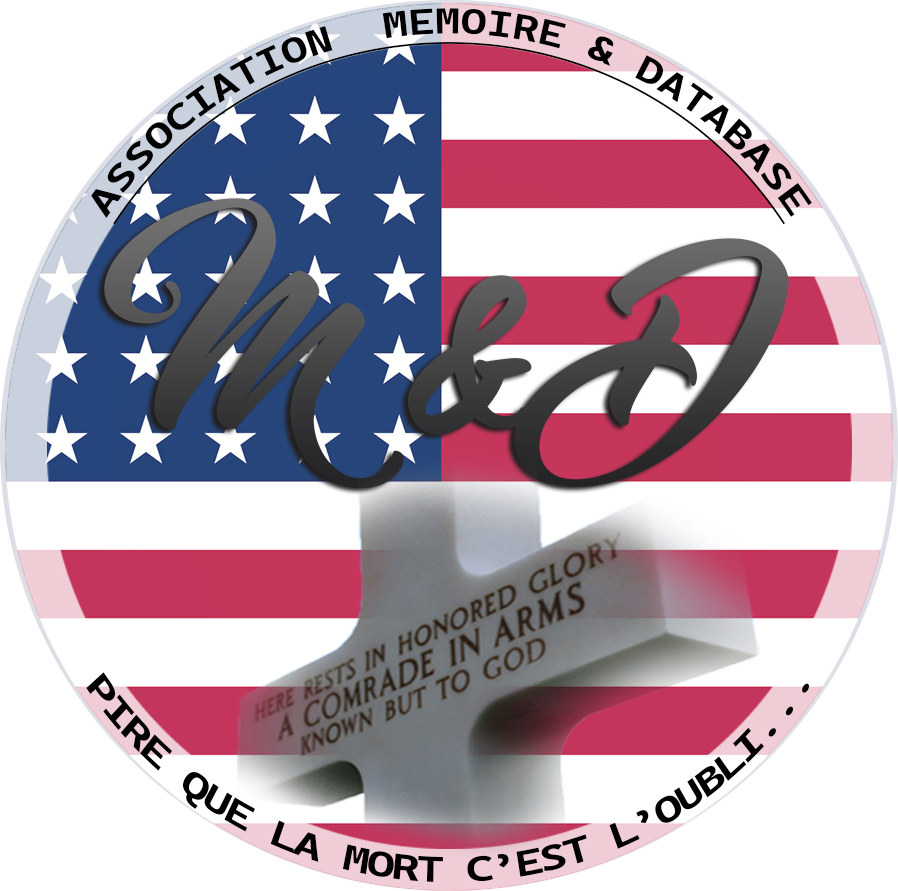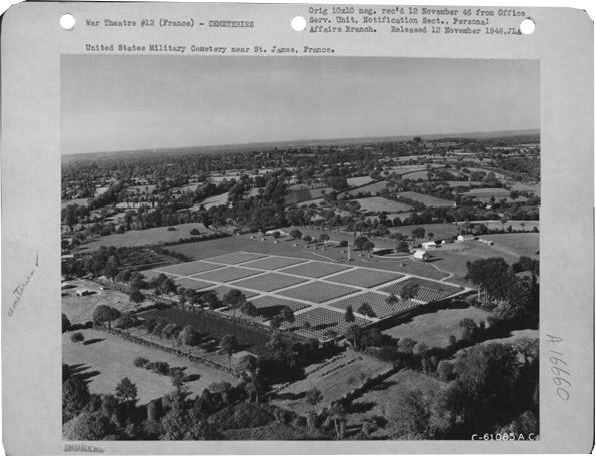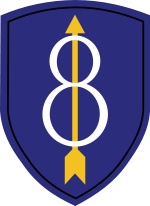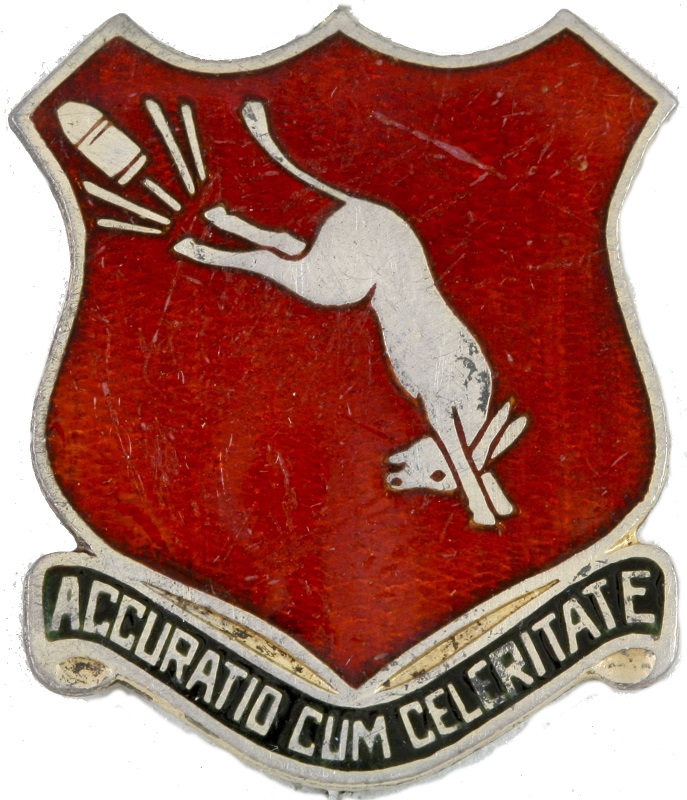|
Andrew Melvin PIERSON
| ||||||||||||||||||||||||
|---|---|---|---|---|---|---|---|---|---|---|---|---|---|---|---|---|---|---|---|---|---|---|---|---|
 | ||||||||||||||||||||||||
| NUMBER OF SERVICE | 33113377 | |||||||||||||||||||||||
| AGE | 28 yo | |||||||||||||||||||||||
| DATE OF BIRTH | 21 February 1916 Pittsburgh PENNSYLVANIA | |||||||||||||||||||||||
| ETAT | Allegheny PENNSYLVANIA | |||||||||||||||||||||||
| FAMILY | Parents : Andrew PIERSON | |||||||||||||||||||||||
| RANK | Technician Fifth Grade | |||||||||||||||||||||||
| FONCTION | ||||||||||||||||||||||||
| JOB BEFORE ENLISTEMENT | Motormen, street, subway, and elevated railway |  | ||||||||||||||||||||||
| DATE of ENLISTEMENT | 24 October 1941 New Cumberland PENNSYLVANIA | |||||||||||||||||||||||
| COMPANY | Company | |||||||||||||||||||||||
| BATTALION | 45th Field Artillery Battalion | |||||||||||||||||||||||
| DIVISION | 8th Infantry Division | |||||||||||||||||||||||
| DATE OF DEATH | 15 September 1944 | 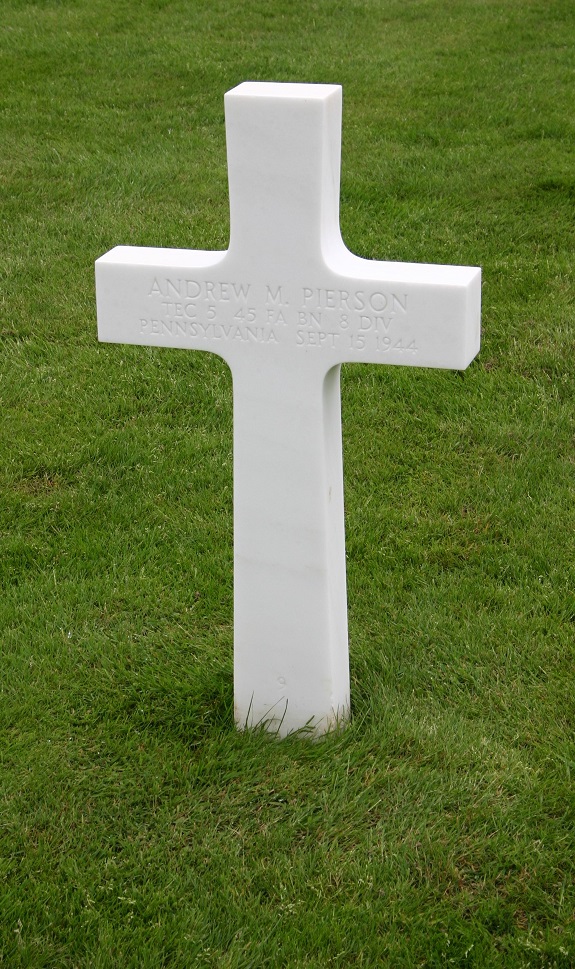 | ||||||||||||||||||||||
| STATUS | KIA | |||||||||||||||||||||||
| PLACE OF DEATH | ||||||||||||||||||||||||
| CEMETERY TEMPORARY |
CEMTERY TEMPORARY of St James N°3578
| |||||||||||||||||||||||
| CEMETERY | BRITTANY AMERICAN CEMETERY of St James | |||||||||||||||||||||||
| GRAVE |
| |||||||||||||||||||||||
| DECORATION |
| |||||||||||||||||||||||
| ||||||||||||||||||||||||
| STORY | ||||||||||||||||||||||||
|
By Maxime RIVIERE When chance does things right.... Andrew M. Pierson was born on February 21, 1916 in Pittsburgh, Pennsylvania. Working in the rail industry, Andrew decided on October 24, 1941 to join the US Army in New Cumberland. He will be assigned to the 45th Field Artillery Battalion of the 8th Infantry Division. After the Battle of Normandy, the 45th FAB was in Brittany. On September 15, 1944, Andrew lost his life in battle. His action leading to his death earned him the Silver Star. Researching another soldier, I contacted Golden Arrow Military Research to obtain General Order No. 99, which lists the names of soldiers posthumously decorated with the Silver Star. At the opening of this one, I had the "surprise" to discover the name of Andrew M. Pierson as well as the reason for the awarding of his Silver Star : "On arriving at his position at a forward observation post, Andrew learned that repeated efforts to establish communication to the rear had been unsuccessful because of intense enemy artillery fire. Whitout hesitation, Andrew, with the assistance of another man, moved out to lay new wire. Proceeding under heavy enemy fire, he moved across exposed terrain and had reached a point within a few yards of his goal when he was caught in a heavy barrage. Refusing to take cover, he continued his efforts until killed by a direct hit. His heroic and outstanding devotion to duty reflects great credit on himself, his organization and military service." First buried in the provisional cemetery of Saint-James, he is now buried in the final cemetery, Block M - Rank 6 - Grave 127. Since 2014,I put flowers on his grave, so it was a great emotion for me to discover his name and the cause of his death. | ||||||||||||||||||||||||
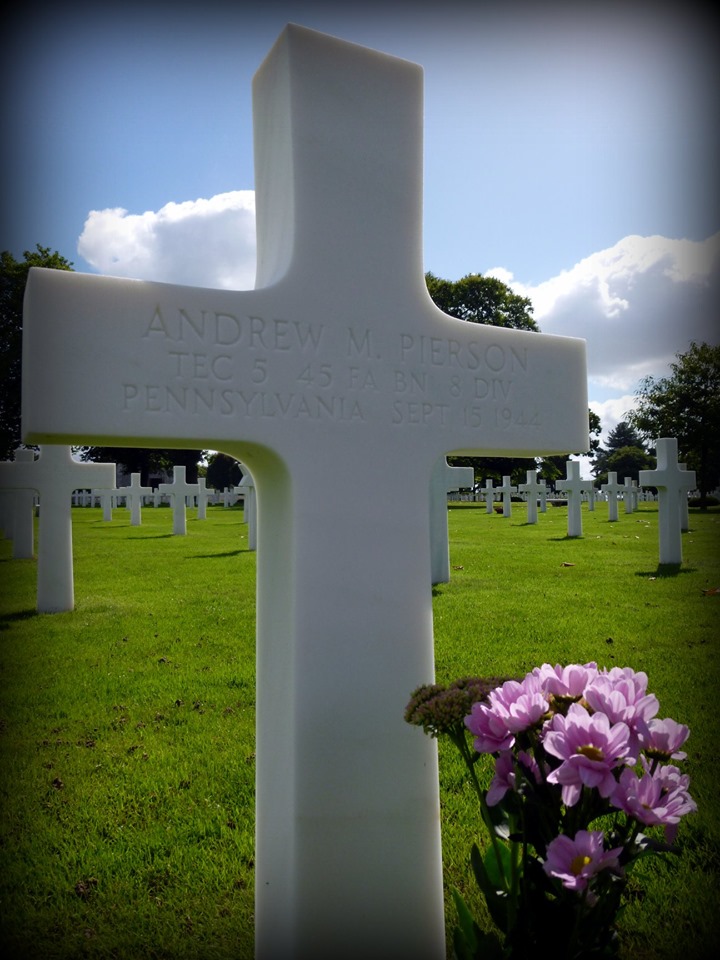 | 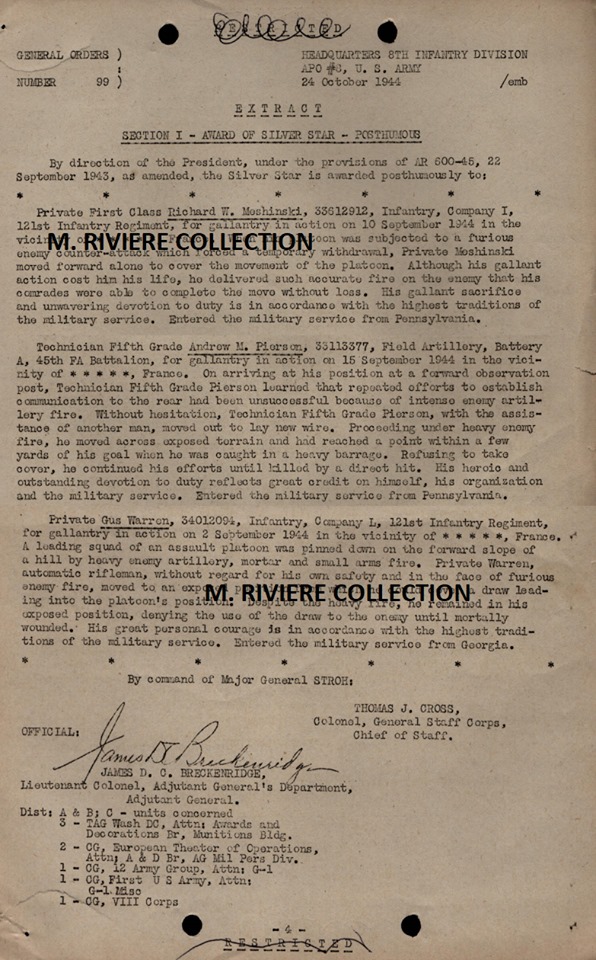 | |||||||||||||||||||||||
Activated/Activé |
Normandy/Normandie |
| 1 Jul 1940 | Days of Combat/Jour de Combat 266 |
| Casualties/Victimes 13 986 | |
Entered Combat/Entré au combat |
|
| 8 Jul 1944 Normandy | |
|
Commanding Generals/Commandants généraux Maj. Gen. Philip B. Peyton (Jun 40 - Dec 40) |
Campaigns/CampagnesNormandy (6 Jun 44 - 24 Jul 44) |
PLAN DE ROUTE DE LA CAMPAGNE - CAMPAIGN ROUTE MAP |
|
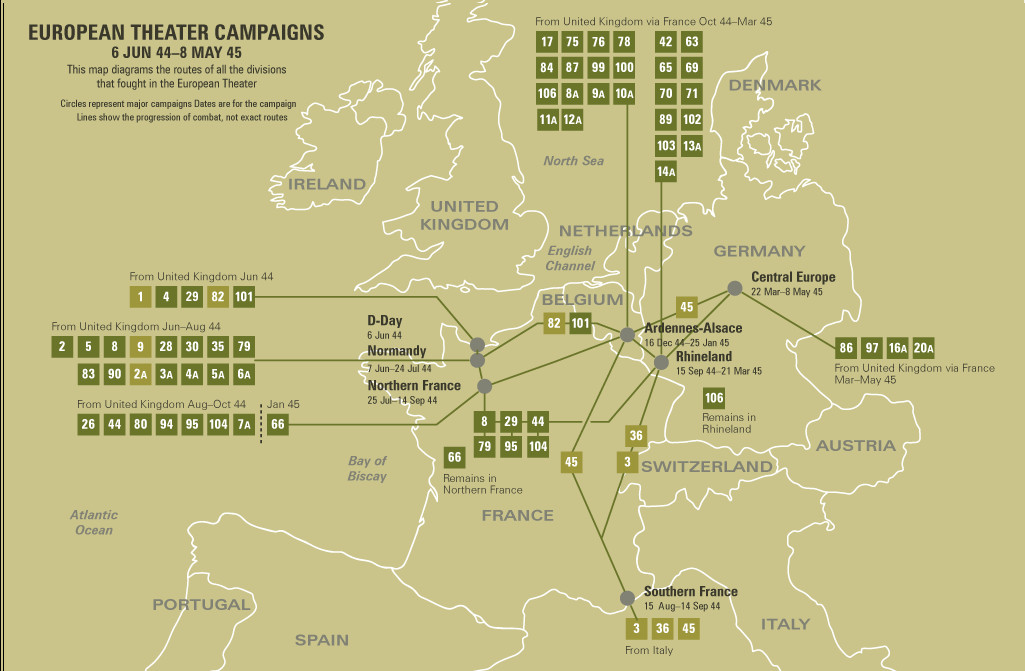 |
|
DIVISION CHRONICLEAfter training in Ireland the 8th Infantry Division landed on Utah Beach, Normandy, 4 July 1944, and entered combat on the 7th. Fighting through the hedgerows, it crossed the Ay River, 26 July, pushed through Rennes, 8 August, and attacked Brest in September. The Crozon Peninsula was cleared, 19 September, and the Division drove across France to Luxembourg, moved to the Hurtgen Forest, 20 November, cleared Hurtgen on the 28th and Brandenburg, 3 December, and pushed on to the Roer. That river was crossed on 23 February 1945, Duren taken on the 25th and the Erft Canal crossed on the 28th. The 8th reached the Rhine near Rodenkirchen, 7 March, and maintained positions along the river near Koln. On 6 April the Division attacked northwest to aid in the destruction of enemy forces in the Ruhr Pocket, and by the 17th had completed its mission. After security duty, the Division, under operational control of the British Second Army, drove across the Elbe, 1 May, and penetrated to Schwerin when the war in Europe ended.
|
CHRONIQUE DE DIVISIONAprès s'être entraîné en Irlande, la 8th Infantry Division débarque à Utah Beach, en Normandie, le 4 juillet 1944, et entre en combat le 7. Traversant les haies, il franchit la rivière Ay, le 26 juillet, traverse Rennes le 8 août et attaque Brest en septembre. La péninsule de Crozon a été défrichée le 19 septembre et la Division a traversé la France jusqu'au Luxembourg, s'est installée dans la forêt de Hurtgen le 20 novembre, a défriché Hurtgen le 28 et Brandebourg le 3 décembre et s'est dirigée vers la Roer. Cette rivière fut franchie le 23 février 1945, Duren fut prise le 25 et le canal Erft traversa le 28. Le 8 a atteint le Rhin près de Rodenkirchen, le 7 mars, et a maintenu des positions le long de la rivière près de Cologne. Le 6 avril, la division attaqua le nord-ouest pour aider à la destruction des forces ennemies dans la poche de la Ruhr. Le 17, elle avait achevé sa mission. Après la sécurité, la Division, sous le contrôle opérationnel de la deuxième armée britannique, traversa l'Elbe le 1er mai et pénétra à Schwerin à la fin de la guerre en Europe. |
| SOURCE INFORMATION & PHOTO | Armydivs.squarespace.com |
|---|
| SOURCE INFORMATION & PHOTO | Aad.archives.gov - Findagrave.com - Maxime RIVIERE - Frédéric LAVERNHE - Abmc.gov - Henri ROGISTER |
|---|---|
| PROGRAMMER | Garrett, Clive, Frédéric & Renaud |


